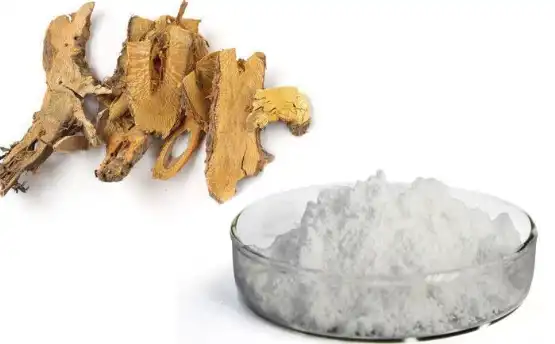What Is the Resveratrol Content in Giant Knotweed Extract?
Giant Knotweed Extract, derived from the Polygonum cuspidatum plant, has garnered significant attention in the health and wellness industry due to its high resveratrol content. This powerful antioxidant compound has been associated with numerous health benefits, making it a sought-after ingredient in dietary supplements and natural health products. In this comprehensive guide, we'll explore the resveratrol content in Giant Knotweed Extract, delving into standard percentages, measurement methods, and factors that influence its concentration.
Standard Resveratrol Percentages in Commercial Extracts
The resveratrol content in commercial Giant Knotweed Extract can vary significantly depending on various factors, including extraction methods, plant quality, and standardization processes. Typically, manufacturers offer extracts with different resveratrol concentrations to cater to diverse market demands and applications.
Common standardized percentages of resveratrol in Giant Knotweed Extract include:
- 5% resveratrol content
- 10% resveratrol content
- 20% resveratrol content
- 50% resveratrol content
- 98% resveratrol content (high-purity extracts)
It's important to note that these percentages refer to the total resveratrol content, which includes both cis- and trans-resveratrol isomers. The trans-resveratrol isomer is generally considered the more bioactive form and is often the focus of research and product development.
Higher resveratrol concentrations are typically associated with more potent extracts, but they may also come with a higher price tag. The choice of concentration depends on the intended application, formulation requirements, and target market segment.
For dietary supplements, concentrations ranging from 20% to 50% are commonly used, striking a balance between potency and cost-effectiveness. Cosmetic and personal care products might opt for lower concentrations, while high-purity extracts (98% and above) are often utilized in research settings or premium nutraceutical formulations.

How Is Trans-Resveratrol Measured in Giant Knotweed?
Accurately measuring the trans-resveratrol content in Giant Knotweed Extract is crucial for quality control, standardization, and ensuring product efficacy. Several analytical methods are employed to quantify resveratrol levels, with High-Performance Liquid Chromatography (HPLC) being the most widely used and reliable technique.
The HPLC method for measuring trans-resveratrol involves the following steps:
- Sample Preparation: The extract is dissolved in an appropriate solvent, typically methanol or ethanol, to create a homogeneous solution.
- Chromatographic Separation: The sample is injected into the HPLC system, where it passes through a specialized column. Different compounds in the extract, including resveratrol, are separated based on their interactions with the column material.
- Detection: As the separated compounds elute from the column, they are detected by a UV-Vis detector, typically set at a wavelength of 306 nm, which is optimal for resveratrol identification.
- Quantification: The peak area or height corresponding to trans-resveratrol is compared to a calibration curve created using pure resveratrol standards to determine the concentration in the sample.
Other advanced techniques that may be used to complement HPLC analysis include:
- Ultra-High Performance Liquid Chromatography (UHPLC): This method offers faster analysis times and improved resolution compared to traditional HPLC.
- Mass Spectrometry (MS): Often coupled with HPLC or UHPLC, MS provides additional specificity and sensitivity in identifying and quantifying resveratrol and related compounds.
- Nuclear Magnetic Resonance (NMR) Spectroscopy: While less common for routine analysis, NMR can provide detailed structural information about resveratrol and other constituents in the extract.
These analytical methods ensure that the resveratrol content stated on product labels accurately reflects the actual concentration in the Giant Knotweed Extract. This precision is essential for maintaining product quality, meeting regulatory requirements, and ensuring consumer trust.
Factors Affecting Resveratrol Concentration in Roots
The resveratrol content in Giant Knotweed roots, and subsequently in the extracted product, can be influenced by various factors. Understanding these variables is crucial for optimizing cultivation practices and extraction processes to achieve consistent, high-quality extracts.
Key factors affecting resveratrol concentration include:
Environmental Conditions:
- Soil Composition: Nutrient-rich soils with proper drainage tend to support higher resveratrol production.
- Climate: Temperature fluctuations and exposure to UV radiation can stimulate resveratrol synthesis as a plant defense mechanism.
- Altitude: Plants grown at higher altitudes often produce more resveratrol due to increased UV exposure and environmental stress.
Harvesting Practices
- Plant Age: Mature plants generally contain higher concentrations of resveratrol compared to younger ones.
- Harvest Time: Seasonal variations can affect resveratrol levels, with some studies suggesting higher concentrations in late summer or early fall.
- Root Section: Different parts of the root system may contain varying amounts of resveratrol, with some research indicating higher concentrations in the root bark.
Post-Harvest Processing:
- Drying Methods: Proper drying techniques help preserve resveratrol content, while excessive heat or prolonged exposure to light can degrade the compound.
- Storage Conditions: Appropriate temperature, humidity, and light control during storage are essential for maintaining resveratrol stability.
Extraction Techniques:
- Solvent Selection: The choice of extraction solvent (e.g., ethanol, methanol, or supercritical CO2) can impact the efficiency of resveratrol extraction.
- Temperature and Pressure: Optimizing these parameters during extraction can maximize resveratrol yield while minimizing degradation.
- Extraction Time: Balancing extraction duration is crucial to ensure maximum resveratrol extraction without compromising quality.
Genetic Factors:
- Plant Variety: Different cultivars or genotypes of Giant Knotweed may naturally produce varying levels of resveratrol.
- Stress Response: Some plants may have a greater genetic predisposition to produce resveratrol in response to environmental stressors.
By carefully managing these factors, cultivators and extract manufacturers can optimize resveratrol content in Giant Knotweed Extract. This attention to detail ensures that the final product meets the desired standardization levels and provides consistent quality for various applications in the health and wellness industry.
The interplay between these factors underscores the complexity of producing high-quality Giant Knotweed Extract. It requires a holistic approach that considers everything from cultivation practices to advanced extraction technologies. This comprehensive understanding allows for the production of extracts with optimal resveratrol content, catering to the growing demand for natural, potent antioxidant ingredients in the global market.
As research in this field continues to evolve, new insights into resveratrol biosynthesis and accumulation in Giant Knotweed may emerge. These advancements could lead to further refinements in cultivation and extraction methods, potentially increasing the resveratrol yield and purity in commercial extracts.
The growing interest in resveratrol-rich extracts like Giant Knotweed has also spurred innovation in delivery systems and formulations. Encapsulation technologies, nanotechnology-based approaches, and novel extraction methods are being explored to enhance the bioavailability and stability of resveratrol in various product applications.
For consumers and manufacturers alike, understanding the factors that influence resveratrol content in Giant Knotweed Extract is crucial for making informed decisions about product quality and efficacy. As the market for natural antioxidants continues to expand, the demand for high-quality, standardized Giant Knotweed Extract is likely to grow, driving further advancements in cultivation, extraction, and analytical techniques.
In conclusion, the resveratrol content in Giant Knotweed Extract is a key factor in its value as a nutraceutical ingredient. From the initial cultivation of the plant to the final extraction and analysis, numerous variables influence the concentration and quality of resveratrol in the extract. By leveraging scientific knowledge and cutting-edge technologies, producers can optimize these factors to deliver consistent, high-quality extracts that meet the evolving needs of the health and wellness industry.
Are you looking for high-quality Giant Knotweed Extract with optimal resveratrol content? Look no further than Angelbio, your trusted partner in natural ingredients for health and wellness products. Our state-of-the-art R&D facilities and commitment to quality ensure that we deliver premium extracts tailored to your specific needs. Whether you're in the business of dietary supplements, cosmetics, or personal care products, our team of experts is ready to assist you in finding the perfect Giant Knotweed Extract solution. Don't compromise on quality – choose Angelbio for your natural ingredient needs. Contact us today at angel@angelbiology.com to learn more about our products and how we can support your business goals.
References
1. Chen, H., et al. (2020). "Resveratrol Content and Antioxidant Properties of Giant Knotweed (Polygonum cuspidatum) Extracts: A Comprehensive Review." Journal of Functional Foods, 75, 104205.
2. Zhang, L., et al. (2019). "Optimization of Extraction and Purification Processes for High-Purity Resveratrol from Giant Knotweed." Separation and Purification Technology, 215, 217-226.
3. Wang, D. G., et al. (2021). "Factors Influencing Resveratrol Accumulation in Giant Knotweed: From Cultivation to Extraction." Industrial Crops and Products, 162, 113289.
4. Liu, Y., et al. (2018). "Comparative Analysis of Resveratrol Content in Different Parts of Giant Knotweed (Polygonum cuspidatum) and Its Correlation with Environmental Factors." Plant Physiology and Biochemistry, 127, 561-568.


